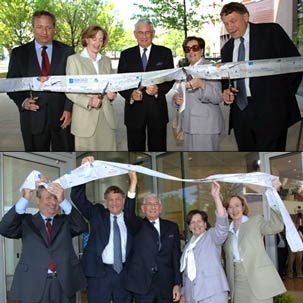Less than two years after the first shovelful of dirt was turned, the Broad Institute of MIT and Harvard officially opened its new building at 7 Cambridge Center on Tuesday, May 30.
The event began with speeches from some of the principals -- Los Angeles-based philanthropists Eli and Edythe L. Broad, MIT President Susan Hockfield, Harvard President Lawrence H. Summers and Broad Director Eric S. Lander -- who shared a long-range vision for the future of biomedicine.
"I believe that the new model for big bioscience that has been established here will become increasingly important as we seek to take full advantage of the tools of modern science and engineering and of the opportunities for creating synergies among them," Hockfield said.
Eli Broad, founder and director of the Broad Foundations, spoke of his and his wife's belief in the promise that human genetics and genomics hold for advancing biomedical knowledge. In particular, he noted the scientific progress made in the three years since the creation of the Broad Institute and attributed such progress to the collaborative spirit that underpins the institute.
"This new Broad Institute building is a monument to collaboration," he said. "We have seen remarkable results when a community of the brightest minds in science today collaborates in very innovative ways."
Recent Broad accomplishments include the sequencing and analysis of the dog genome, the completion of phase I of the International Haplotype Map Project, the creation of the RNAi Consortium's RNAi library, and new insights into human evolution.
Speaking in the airy sunlit atrium, Lander said, "This building embodies the principle that I think is most essential to the work of this generation, and that is openness."
The Broad Institute brings together two world-class universities, Harvard University and MIT, and their affiliated institutions and hospitals throughout Cambridge and Greater Boston. During its relatively brief existence to date, the Broad has operated in five distinct locations, including its central building at 320 Charles St.
The construction of the newest building emerged from the Broad's research efforts that reach across scientific disciplines as well as institutions. The building stands on the last major plot in the Cambridge Center area within the heart of Kendall Square, and thereby completes an urban renewal project that began some 30 years ago.
"This building is a scientific instrument -- because of what it will make possible, because of the collaborations that it permits, because of the instrumentation that it houses, and because of the facility that it provides for bringing people together," Summers said. "We are going to be able to see further, we are going to be able to see better, than we otherwise could have seen."
The revealing design of the new building is grounded in its own type of collaboration, reflecting the work of an architectural team led by Elkus-Manfredi Architects and including Signer/Harris Architects and Maryann Thompson Associates.
The morning event concluded with the ceremonial cutting of a ribbon imprinted with scientific data generated at the Broad Institute.
A version of this article appeared in MIT Tech Talk on June 7, 2006 (download PDF).






